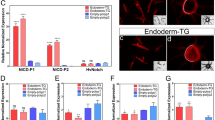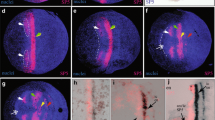Summary
A mutant ofHydra attenuata is analysed, theaberrant, which is distinct from the wild type in having a smaller head with fewer tentacles and only half the number of head-specific cells. The rate of head and foot regeneration and the doubling time are slower inaberrants than in normal hydra.
The lower head-forming potential is paralleled by a reduced concentration of head-specific morphogens: compared to the wild type, in theaberrant the concentration of head activator is reduced to 70% in the head and to 50% in the body, the concentration of head inhibitor is reduced to 50% in the head and to 80% in the body. Theaberrant is more sensitive (3 times) to added head activator and less sensitive (>5 times) to added head inhibitor than the wild type.
The slower rate of foot regeneration is paralleled by a lower content of foot-specific morphogens: compared to the wild type, in theaberrant the foot activator is reduced to 40% and the foot inhibitor to 70%.
Similar content being viewed by others
References
Berking, S.: Bud formation inhydra: Inhibition by an endogenous morphogen. Wilhelm Roux's Archives181, 215–225 (1977)
Bode, H., Berking, S., David, C. N., Gierer, A., Schaller, H. C., Trenkner, E.: Quantitative analysis of cell types during growth and morphogenesis in hydra. Wilhelm Roux' Archiv171, 269–285 (1975)
David, C. N.: Quantitative method for maceration of hydra tissue. Wilhelm Roux' Archiv171, 259–268 (1973)
Gierer, A., Berking, S., Bode, H., David, C. N., Flick, K., Hansmann, G., Schaller, H. C., Trenkner, E.: Regeneration of hydra from reaggregated cells. Nature New Biol239, 98–101 (1972)
Lenhoff, H. M., Brown, R. D.: Mass culture in hydra: an improved method and its application to other aquatic invertebrates. Lab. Animals4, 139–154 (1970)
Schaller, H. C.: Isolation and characterization of a low-molecular-weight substance activating head and bud formation in hydra. J. Embryol. exp. Morph.29, 27–38 (1973)
Schaller, H. C.: Head activator controls head formation in reaggregated cells of hydra. Cell Diff.4, 265–272 (1975)
Schaller, H. C.: Action of the head activator as a growth hormone in hydra. Cell Diff.5, 1–12 (1976a)
Schaller, H. C.: Head regeneration is initiated by the release of head activator and inhibitor. Wilhelm Roux's Archives180, 287–295 (1976b)
Schaller, H. C., Grimmelikhuijzen, C. J. P., Schmidt, T.: Isolation of substance controlling morphogenesis in hydra, inExperimental Methods in Hydra Research, Lenhoff, H. M. (ed.), Plenum Press (1977) in press
Schmidt, T., Schaller, H. C.: Evidence for a foot-inhibiting substance in hydra. Cell Diff.5, 151–159 (1976)
Author information
Authors and Affiliations
Rights and permissions
About this article
Cite this article
Schaller, H.C., Schmidt, T., Flick, K. et al. Analysis of morphogenetic mutants of hydra. Wilhelm Roux' Archiv 183, 193–206 (1977). https://doi.org/10.1007/BF00867320
Received:
Accepted:
Issue Date:
DOI: https://doi.org/10.1007/BF00867320




